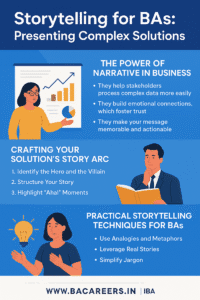
Are your presentations often met with blank looks or just polite nods? You’ve done the work—analyzed data, designed processes, and come up with smart ideas—but when it’s time to present, the group seems lost.
That’s because numbers and facts alone don’t grab people‘s attention—stories do.
In today‘s busy business world, Business Analysts need to do more than just show results.
They need to connect with people, build trust, and make others want to take action.
Let’s see how using stories can turn your presentations from boring to engaging.
The Power of Storytelling in Business
People love stories.
From ancient drawings on cave walls to today‘s popular talks, we remember stories, not just lists of numbers.
For a Business Analyst, storytelling helps make complex data easier to understand and connect with business goals.
Why stories work:
They help people understand complicated data better.
They build trust by showing real feelings and connections.
They make your message stick and show what action to take.
Example:
Imagine a BA talking about a new automation tool.
Instead of saying:
“Using this tool cuts manual work by 40%.”
Try this:
“Meet Priya, our operations manager, who spends half her day checking invoices.
With our new tool, she’ll finally have time to focus on solving problems, not just entering data.”
Suddenly, people care.
They can see the real difference.
Real–life Example:
In a bank, a BA used a story–based approach to get support for a compliance project.
By focusing on “keeping customers safe” instead of “upgrading systems,” leadership approved the project quickly—within one meeting.
1.
Identify the Hero and the Villain
Hero: Your customer, user, or stakeholder
Villain: The problem, inefficiency, or risk
Example:
“Finance managers (the hero) get stuck with manual work (the villain).
Our new tool (the solution) helps them escape the mess of data entry.”
2.
Structure Your Story
Beginning: The current situation—what’s wrong or inefficient
Middle: The journey—your solution and how it changes things
End: The future—how much better things get, how efficient, or how happy customers are
3.
Highlight ‘Aha!’ Moments
Show key ideas that make your audience say, “Oh, I get it now!”
For example, show how dashboards save time and help people make better decisions.
Tip:
If you’re presenting in a workshop or sprint review, use visuals—flow diagrams, before-and-after charts, or short user stories can make your message more real.Effective Requirement Elicitation Techniques
— Learn how to get the details that help build your story.
Practical Storytelling Tips for BAs
Here‘s how to use storytelling in your everyday presentations.
1.
Use Analogies and Metaphors
Make complex ideas simple by comparing them to something familiar.
Example:
“Think of this workflow like a GPS—it shows the way and warns about traffic ahead.”
2.
Use Real Stories
Client stories: Show the human side of success.
Case studies: Share real outcomes, not just features.
Personal stories: Share lessons from past projects.
3.
Simplify Jargon
Use simple business language instead of technical terms.
Example:
Instead of saying “API integration reduces latency,” say, “Our systems will finally work together in real–time.”
4.
Use Visual Storytelling
Use pictures—process maps, storyboards, or mockups—to help your audience “see” the story.
Tools like Miro, Lucidchart, or Figma can help.
Your Call to Action: Be a Storytelling BA
Key Points:
Facts help, but stories move people.
A clear story turns complex ideas into easy-to-understand messages.
Storytelling makes you a better communicator and change–maker.
Try This:
In your next presentation, replace one data slide with a story—someone real, a problem they face, and how your solution helps them.
You’ll notice the difference right away—more interest, more questions, and more support.
Conclusion
Storytelling isn’t just a “soft skill”—it’s a powerful way to communicate that sets good BAs apart from great ones.
When you tell a story, you don’t just show data—you inspire people to act, build trust, and create real change.
So, the next time you’re making a BRD, an executive presentation, or a sprint demo, remember:
Don’t just show the data.
Tell the story behind it.
PMI – The Importance of Communication in Project Success.
🔗 Related Articles:
🌐 External Links

Business Analyst , Functional Consultant, Provide Training on Business Analysis and SDLC Methodologies.
